I ended my “Comments” of 21 February with anthropologist Kumar Mahabir’s opinion that a re-scripting of the “Black Power” label might have seen more Indo-Trinbagonians eagerly embracing the movement. This will remain an open question. But if his reactions to other aspects of Afro-Trinidadian cultural engineering without the “black” label (as seen in the steelpan, calypso, Carnival, Best Village, etc.) were measured by the same yardstick, the answer would lean more toward the negative. Something more fundamental than a label is at play.
Mahabir is on solid ground with his insistence on the right of Indians to define or redefine their identity to ensure visibility in a highly competitive cosmopolitan milieu such as T&T. Nevertheless, his contention that Indian organisations or the Indian masses could not reasonably be expected to participate in the Black Power demonstrations of 1970 because “Black” equates with “African” is illogical and ahistorical.
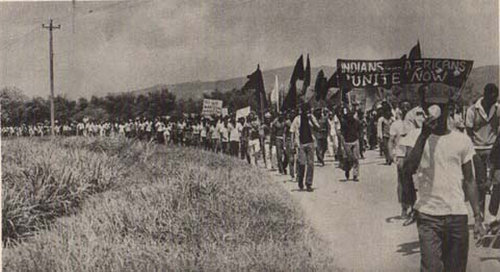
(Courtesy Embau Moheni/NJAC)
To best illustrate my point, here is a lesson straight out of the Anti-Apartheid struggle in South Africa. Segregation laws and policies were intended to keep every group separate from each other. The evidence, however, shows that ethnic unity and cooperation were constantly being brokered among the oppressed groups.
In an interview given in 1968, Dr Yusuf Dadoo explains the Indo-South African involvement in the African National Congress’ (ANC) military phase of the struggle: “The militant Indian youth, who played not an insignificant part in the early struggles of Umkhonto since 1961 […] have yet a larger role to play in the liberation army, and in mobilising the Indian people in town and country to support and help the freedom fighters in every possible way. The Indian people must and will, I am certain, help to make the path of freedom fighters easy.” [South African History Online, SAHO]. Umkhonto is short for Umkhonto we Sizwe (Spear of the Nation), the armed wing of the ANC.
In the main, these militant Indians belonged to the South African Communist Party as well as various Indian congresses such as the South African Indian Congress and the Natal Indian Congress. Dadoo asserted that “freedom is indivisible” and that “no fundamental changes were possible without unity.” Indeed, in the Indian-orchestrated Passive Resistance Campaign against the Asiatic Land Tenure and Indian Representation Act in 1946, “African and Coloured volunteers participated as a gesture of solidarity.”
Dadoo testified that this gesture was critical and “laid a strong basis among the Indian people for the subsequent unity with the African National Congress…” Accordingly, the 1952 Defiance Campaign organised by the ANC “welded the masses of the African, Coloured and Indian peoples into a united force.”
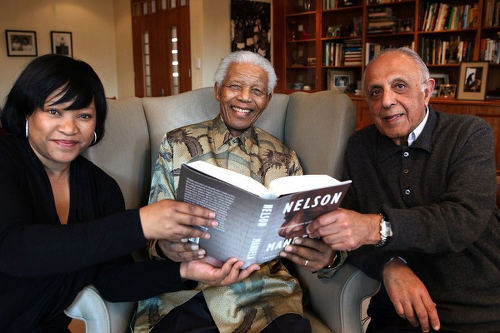
Another Indian-South African anti-Apartheid stalwart worth mentioning is Ahmed Kathrada, who was even more centrally involved than Dadoo in the ANC and Umkhonto. Dadoo went into exile in Britain but Kathrada was, together with Nelson Mandela and other ANC operatives, sentenced to life imprisonment on Robben Island. At no time did these stalwarts of anti-Apartheid suggest that their Indianness was compromised by identification with ANC militancy.
Apartheid-era inter-ethnic collaboration demonstrates that Indian organisations in T&T could equally have participated in the Black Power movement under their own banners. If he were a nationalist, Bhadase Maraj could have persuaded his subordinates to support the BP movement without losing face or political status; but even if his influence in the Hindu community were diminished by openly supporting BP, history would have absolved him as a national hero.
With no religious or political base of their own, anti-colonialist Indo-Trinbagonians like Brinsley Samaroo, Basdeo Panday, Winston Leonard, Chan Maharaj and Kenneth Parmasad defiantly broke the ceiling of ethnic separation that Maraj aggressively sought to keep intact. Ironically, according to historian Jerome Teelucksingh, Parmasad was an executive member of SPIC, the organisation that was founded expressly to immunise Indian students on the UWI campus against the influence of Black Power.
As a member of the Workers and Farmers Party, former prime minister Panday had also addressed a Black Power meeting in Couva. Against the backdrop of disinformation intended to create a wedge between Africans and Indians, Maharaj addressed a crowd of some 20,000 on the eve of the 1970 “March to Caroni,” affirming: “Black Power has not turned against the Indian community. If you are not white, you are black. Black Power is not confined to those of the African race,” [Jerome Teelucksingh, “The Black Power Movement in Trinidad and Tobago,” in Black Diaspora Review, vol. 4 (2014].
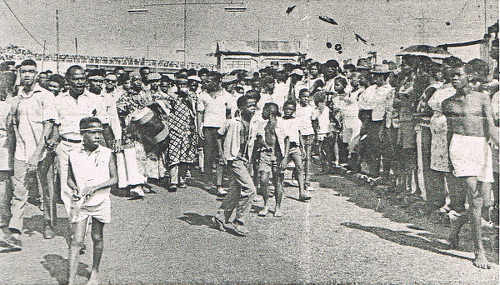
(Courtesy Embau Moheni/NJAC)
Maharaj’s message was straight out of the pages of Dadoo, Kathrada and other like-minded Indians in South Africa and consistent with the philosophy of the T&T Black Power movement. Unfortunately, Mahabir misses this sense of history. The Black Power movement was a struggle against Caribbean-style apartheid, less physically violent but no less detrimental to African and Indian humanity, civil rights and economic progress than the South African or American systems.
Ironically, as a secondary diaspora in England, Indo-Trinidadians had less issues with officially assuming a “black” identity than in T&T. My first knowledge of this was from personal experience. While I was in the British Archives in the mid-1990s, one of the desk clerks said to me that she was planning on returning to Trinidad soon although she had just got a promotion. The reason: “It’s getting harder here for us black people; too much racism.” She was Indian. After studying the UK censuses, I can now better understand her embrace of black identity.
Most Indo- and Afro-Trinidadians in Britain are products of post-Second World War migrations beginning with the MV Empire Windrush out of Kingston, Jamaica in 1948. The majority of passengers on board the Windrush were Jamaican but many other British Caribbean islands were also represented.
In plantation/slavery days, metropolitan British writers equated the British West Indies with Jamaica. Influenced considerably by the predominance of Jamaican immigrants from the Windrush onward, Jamaicanisation continued to inform late-20th Century British thought on Caribbean identity, as evidenced in the everyday description of Caribbean immigrants: “Black,” “Coloured,” “West Indian,” “Jamaican.”
The 1981 UK census categorised British-Caribbean subjects simply as “West Indian.” The architects of the 1991 census, however, arbitrarily imposed the hegemonic identity “Black-Caribbean” on the same demographic. The presumptive “black” identity also included “Black-African” and an anomalous “Black-Other.” Did the British, the pioneers of racism, truly consider Indo-Caribbeans “black”?
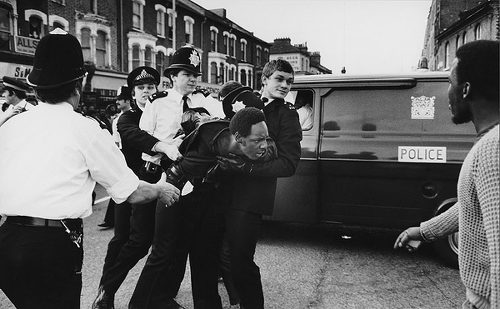
(Copyright Hooch.net)
According to sociologist, Susanne Mulhleisen, “While they were uniformly seen by the whites as part of the mass of ‘coloured immigrants,’ their loyalties were often torn between a newly found positive affirmation of black identity and an association with the large Indian community from the subcontinent.” (From Susanne Mulhleisen, Creole Discourse, 2002). Over time, as they acquiesced in the reality of the true nature of British racism, the antipathy to “black” ethnic identity largely disappeared. As Stephen Vertovec explains, “Overall, most young British Indo-Caribbeans seem much readier to adopt a general ‘black’ political identity than their parents…”
In social theory, the term “situational ethnicity” may best explain the Indo-Caribbean British acceptance of a “Black” identity. Simply put, situational ethnicity is an ethnic identity adopted as expedient or pragmatic in a given socio-political situation.
Vertovec’s explanation, however, is not sufficiently explicit. The truth is that Indo-Trinbagonians assimilated this “black” identity—which received only contempt in T&T—because they had no choice and because of pragmatism.
To an Indo-Caribbean person, being “Black-Caribbean” was politically advantageous over all the Asian categories: for example, winning a seat in a Council was only possible with the votes of a heterogeneous Black-Caribbean constituency. Furthermore, an Indo-Caribbean person could not actually identify as “Indian” because that identity was reserved for persons holding passports from the largest of the three entities called “India” under British rule as well as their offspring born in Britain; persons originating in the two separated entities were labelled “Pakistani” and “Bangladeshi.” “Chinese” was the only other distinct Asian identity.
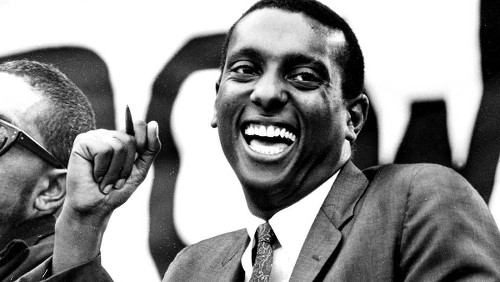
In 2001, UK census “Black” was modified into “Black/Black British.” In the latest English census of 2011, there was further refinement. Indo- and Afro-Trinbagonians were still faced with the primary identity “Black.” The relevant category was headlined “Black/African/Caribbean/Black British.” The options under this heading were “African,” “Caribbean” and “Any other Black/African/Caribbean background” (which had to be stated in writing).
The selection of “Caribbean/Other” would not have provided an authentic loophole for Indo-Caribbeans to establish a separate identity. In a comparative analysis of the 2001 and 2011 censuses, the “Black or Black British” category was equated with its “Caribbean” and “African” subsets as well as “Other.” Thus, if Indo-Caribbeans selected the sub-set, “Other,” they would still belong to the universal “Black” entity.
It should be noted that the perception of Indians as “black” did not originate with post-WWII Britons. The English had applied the term “black” to the small group of the first recorded Indians in Britain in the early 17th century [see Ali Riad, Islam and Identity Politics among British-Bangladeshis (2013)]. Before the Portuguese ascription “Laskars” was applied to a certain segment of Indian seamen, the first English colonists in India used to refer to them as “Black Portuguese.” Furthermore, “Indian Laskars” were included among the “black poor,” whom the British expelled from London to Sierra Leone in 1787.
“Creole” is even more problematic ethnic identifier than “black.” The Spaniards were the first to deploy the term (criollo) in the Caribbean to apply to colonists born in the Americas. Interestingly, linguist Maureen Warner-Lewis argues that the Spaniards had merely hispanicised a word from Ki-Kongo, the language of the people of the Kingdom of Kongo in west-central Africa. Over time, “creole” applied to any person born in the colonial Caribbean of European parentage as well as to the distinct language and culture associated with this demographic.
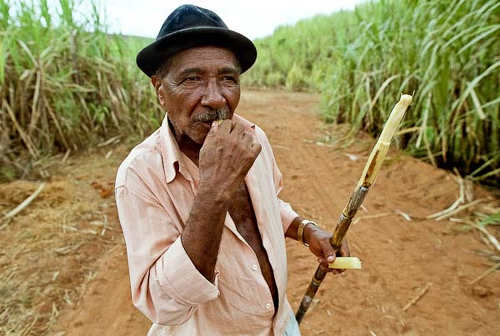
(Courtesy Riomate)
Whereas Spanish colonists had deployed distinctive terms for Africans born in the colonies, English and French colonials applied the “creole” label also to Africans, whether free or enslaved. Edward Long, an influential Jamaican planter-historian-legislator, was the first English intellectual to politicize the term “creole;” he advocated for the acceleration of creolisation of enslaved labour as a mechanism for reducing insurrections, which he strongly linked to native Africans (History of Jamaica (1774).
Before the end of the 19th Century, descendants of all new immigrant ethnic groups without exception had carried the creole label in T&T. In his book Trinidad in Transition, Historian Donald Wood acknowledges the deployment of the term “Indian creole” in the late-19th Century.
Over time, however, Indo-Trinbagonians (as well as other ethnic groups that had shed their creole label) commonly equated “creole” with “African” or its many derogatory synonyms and have fought a long battle to delegitimise its application to them.
Ironically, before Independence, it seems that this process was as actively propagated by calypsonians as Indians. As early as the 1930s and 1940s, Indian women were the subject of quite a few calypsoes. For example, while Mighty Killer (Cephas Alexander) would sometimes casually use the vulgar term “coolie”, his songs significantly neutralised the “creole” identity. In the song, “Indians Adopting Creole Names,” he observes, “…there is no Indian again/Since the women and them taking Creole name” (Tejaswini Niranjana, Mobilizing India, 2006).
He persistently describes them as “Indian,” not “creole.” He expresses dismay—Niranjana sees it as “hostility”—at what he perceives as a trend in shedding Indian names for “creole” names.
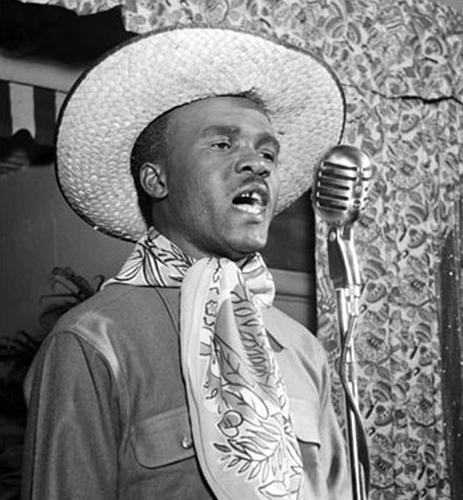
Like many of his day, and even now, Killer mistakenly assumes that creole names are traditional names of African peoples. Accordingly, Killer dichotomises Indian and creole, whereas in the same calypso, he equates “creole” with “nigger,” the most pejorative English ascription for African peoples. Similarly, Lord Invader (Rupert Grant) sang of his fantasy for “a nice Indian girl that is creolise,” and not a nice creole Indian or Indian creole girl.
Equally ironic, the post-Independence perpetuation of “creole” in preference to “African” was largely promoted by Indo-Trinbagonians. During the 1960s, universal secondary education brought an end to public use of the derogatory terms, “coolie” and “nigger.” “Indian” or “East Indian” was widely accepted as the primary Indo-Trinbagonian ethnicity.
In the main, however, while the term “nigger” was successfully exorcised, it merely reinforced the “negro,” “black” and “creole” labels. The Black Power movement, to which calypsonians made a significant contribution, only partially succeeded in cultivating a primary “African” identity.
In my next column, I shall address some of the problems of identity that the advocates of “Black consciousness” faced during the Black Power movement.
Claudius Fergus is a retired Senior Lecturer in the Department of History at UWI’s St Augustine Campus who specialises in the abolition of British colonial slavery and its transatlantic slave trade.
His major work on the subject is Revolutionary Emancipation: Slavery and Abolitionism in the British West Indies (2013). He has other extensive publications in peer-reviewed journals and edited books.
 Wired868 Wired868 for smart sport news and opinion
Wired868 Wired868 for smart sport news and opinion

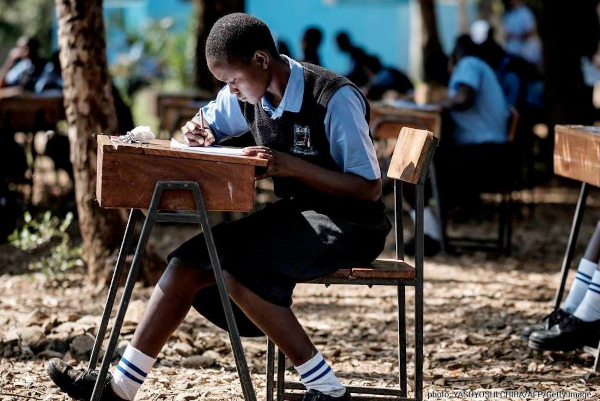
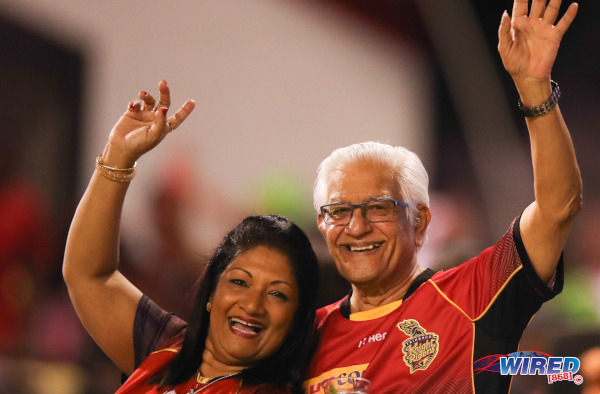
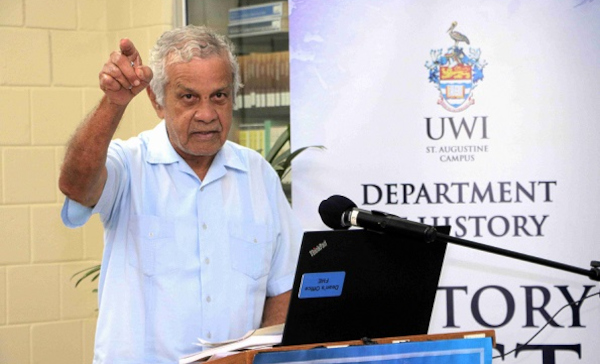
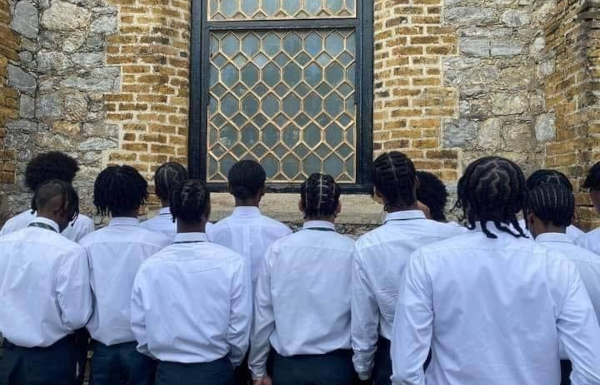
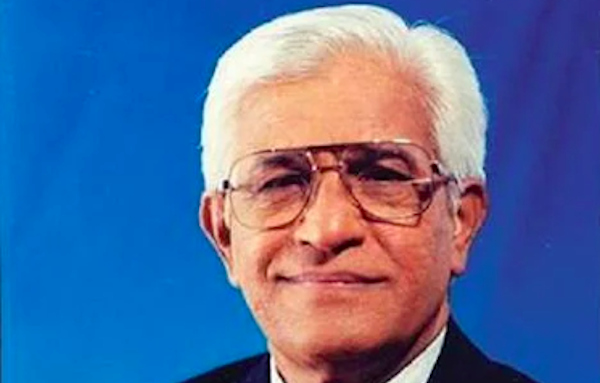

I have just returned from a Notting Hill Carnival meeting where a Trinidadian Indian descendent chaired half the meeting. He is in no way a pioneer in that regard, as until the day he goes home to his parents’ village in San Fernando, he is expected to mix and mingle with us migrated Black refugees from Laventille and Tunapuna. Returning to Trinidad open to prejudicial influences can be deadly for race relations on the return to UK. He has a cockney tinge about his speech, but he is a professional man so it can be assumed to be a confusion of his adaptation to a Carnival meeting environment.
Indo Trinidadians in London marry Sri Lankans, live in middle class suburbs and impress their in-laws by getting drunk with African elites. They did well to avoid Paki bashing, the phase when White rude boys hunted Indians by night to beat them up. Of course they have a better understanding of sub continental Indians but they are identifiably different: many assume the countenance, they imagine, of one of VS Naipaul’s Miguel Street, smartman characters.
I have experience of twice being offered money by a desperate sub continental Indian to sit next to me on the bus while he was being chased by White rude boys in their Paki Bashing phase. In my work, usually in White dominated freelance environments, it is not uncommon for White colleagues to gang up on an Indian or a negro to demonstrate their White supremacy. We were five, three Black and two Indian, on a big public utility company project of 600 in Birmingham, an Indian settled area. There were many anti Indian racist moves visible to me by White colleagues, but it was an Indian who warned me of the Jewish conspiracy against me, allowing me, in my victory, to continue earning for another year.
I get knocked down a lot because I chose to live abroad but what I see is while we fight each other, we ignore the wider reality: that the global division across the board is white, then everyone else. Wakanda Forever.
Great point Kala Ramnath. Maybe if the apartheid was stronger in T&T it would have united the Afro and Indo populations more, against a common adversary. What we had was soft apartheid, colorism and classism.
What we had was the hijacking of the African/Indian solidarity of the 1930s (Indians referred to Butler as ‘Mahatma’) by the Afro-Saxonised political aspirants trained by the British and French elites who, since the coming of Indentured Indians struggled to keep both ethnic group apart and in suspicion of each other.
Thought-provoking piece. I thought of THE south Africa. Experience when I read the headline as Indos there were very much at the heart of the struggle. Madiba’s closest friends were Mac Maharaj and Ahmed Kathrada. Two things: South African dynamic was different to Tdad’s. Second, its liberation leaders were an extremely intellectual and extremely sophisticated bunch of people. They were all shaped by liberation theology and marxism regardless of differences. I think that and size made a difference.